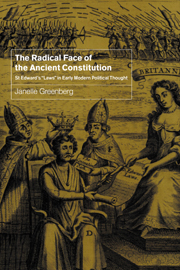Book contents
- Frontmatter
- Contents
- Acknowledgments
- 1 Hagiography and historiography: the long shadow of Edward the Confessor
- 2 “Those most noble and equitable laws of St. Edward”: from the cult of the Confessor to the cult of the Confessor's laws
- 3 “Divers and sundry ancient histories and chronicles”: the articulation of the ancient constitution in the Tudor period
- 4 “By lex terrae is meant the laws of St. Edward the Confessor”: the footprints of the Saxons in the early seventeenth century
- 5 “You shall be king while you rule well”: the radical ancient constitution in the civil wars and interregnum
- 6 “That noble transcript of the original contract, the Confessor's laws”: the radical ancient constitution in the late Stuart period
- Bibliography
- Index
4 - “By lex terrae is meant the laws of St. Edward the Confessor”: the footprints of the Saxons in the early seventeenth century
Published online by Cambridge University Press: 29 August 2009
- Frontmatter
- Contents
- Acknowledgments
- 1 Hagiography and historiography: the long shadow of Edward the Confessor
- 2 “Those most noble and equitable laws of St. Edward”: from the cult of the Confessor to the cult of the Confessor's laws
- 3 “Divers and sundry ancient histories and chronicles”: the articulation of the ancient constitution in the Tudor period
- 4 “By lex terrae is meant the laws of St. Edward the Confessor”: the footprints of the Saxons in the early seventeenth century
- 5 “You shall be king while you rule well”: the radical ancient constitution in the civil wars and interregnum
- 6 “That noble transcript of the original contract, the Confessor's laws”: the radical ancient constitution in the late Stuart period
- Bibliography
- Index
Summary
INTRODUCTION
The ancient constitutionalist vision of the past and the sources upon which it rested continued to be nourished by early seventeenth-century chroniclers, antiquaries, and the most erudite scholars of the era. Indeed, according to Glenn Burgess, this was the heyday of the ancient constitution. Occasionally, to be sure, writers differed as to whether it originated with the Britons or the Saxons, or whether each and every institution of Stuart government began in antiquity. Still, many learned Englishmen traced the essentials of their polity to the pre-1066 period, and many insisted that these survived the conquest intact as a result of consecutive royal promises. Their differences appear, then, as mere variations upon the theme of historical continuity from pre-conquest times to the seventeenth century.
Moreover, during the early Stuart period the ancient constitutionalist version of the past retained its plasticity. As in the middle ages and Tudor period, it was used to justify different, even antithetical, political ends. Indeed, so malleable was the ancient constitution of the pre-civil war period that it could accommodate a belief in divine right monarchy as well as a reverence for an immemorial parliament and common law. In Derek Hirst's words, the early modern mind was capable of conceiving “of both a sovereign king and a sovereign common law,” of both “absolute royal prerogatives and absolute rights to property.” The ease with which it did so is apparent in the writings of the oracle of the common law, Sir Edward Coke.
- Type
- Chapter
- Information
- The Radical Face of the Ancient ConstitutionSt Edward's 'Laws' in Early Modern Political Thought, pp. 116 - 181Publisher: Cambridge University PressPrint publication year: 2001



